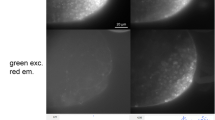Summary
UsingAllium cepa chromosomes after 5-bromo, 2′-deoxyuridine (BrdU) incorporation, we studied several acid and basic dyes and fluorochromes for their potential as substitutes for 33258 Hoechst in the fluorescence-plus-Giemsa (FPG) technique. All of the dyes and fluorochromes investigated showed a photosensitizing capacity which was slightly lower than 33258 Hoechst in the cases of daunomycin, phloxin, fluorescein, thioflavine T and nuclear fast red, and somewhat higher in the case of eosin Y. Observation and cytophotometric analysis of differentially Giemsa-stained sister chromatids when eosin Y was used as the photosensitizing agent revealed the unsubstituted chromatid to be reddish violet in colour (absorption maximum, 550 nm), while the BrdU-substituted chromatid was blue or pale violet blue (absorption maximum, 580 nm). These results indicate that eosin Y is a useful photosensitizing dye which could be used as a substitute for 33258 Hocchst in the FPG staining technique
Similar content being viewed by others
References
Bergeron JA, Singer M (1958) Metachromasy: an experimental and theoretical reevaluation. J Biophys Biochem Cytol 4:433–457
Burkholder GD (1982) The mechanisms responsible for reciprocal BrdU-Giemsa staining. Exp Cell Res 141:127–137
Buys CHCM, Van der Veen AY (1982) Different effects of 33258 Hoechst and DAPI in fluorescent staining of sister chromatids differentially substituted with bromodeoxyuridine. Histochemistry 75:169–177
Comings DE (1975) Mechanisms of chromosome banding. IV. Optical properties of the Giemsa dyes. Chromosoma 50:89–110
Dutrillaux B, laurent C, Couturier S, Lejeune J (1973) Coloration par l'acridine orange des chromosomes prealablement traités par le 5-BrdU. C R Acad Sci (Paris) 276:3179–3181
Dutrillaux B, Fossé AM, Prieur M, Lejeune J (1974) Traitement au BUDR (5-bromodeoxyuridine) et fluorescence bicolore par l'acridine orange. Chromosoma 48:327–340
Epplen JT, Siebers JW, Vogel W (1975) DNA replication patterns of human chromosomes from fibroblasts and amniotic fluid cells revealed by a Giemsa staining technique. Cytogenet Cell Genet 15:177–185
Galbraith W, Marshall PN, Bacus JW (1980) Microspectrophotometric studies of Romanowsky stained blood cells. J Microsc 119:313–330
Goto K, Akematsu T, Shimazu H, Sugiyama T (1975) Simple differential Giemsa staining of sister chromatids after treatment with photosensitive dyes and exposure to light and the mechanism of staining. Chromosoma 53:223–230
Kato H (1974) Spontaneous sister chromatid exchanges detected by a BUdR-labelling method. Nature 251:70–72
Kihlman BA, Kronborg D (1975) Sister chromatid exchanges inVicia faba. Demonstration by modified fluorescence plus Giemsa (FPG) technique. Chromosoma 51:1–10
Kim MA (1974) Chromatid exchange and heterochromatin alteration of human chromosomes with BUDR-labelling demonstrated by benzimidazol fluorochrome and Giemsa stain. Humangenetik 25:170–188
Korenberg JR, Freedlender EF (1974) Giemsa technique for the detection of sister chromatid exchanges. Chromosoma 48:355–360
Latt SA (1973) Microfluorometric detection of deoxyribonucleic acid replication in human metaphase chromosomes. Proc Natl Acad Sci USA 70:3395–3399
Latt SA (1974) Sister chromatid exchanges, indices of human chromosome damage and repair: Detection by fluorescence and induction by mitomycin C. Proc Natl Acad Sci USA 71:3162–3166
Latt SA (1977) Fluometric detection of deoxyribonucleic acid synthesis. Possibilities for interfacing bromodeoxyuridine dye techniques with flow fluorometry. J Histochem Cytochem 25:913–926
Latt SA, Willard HF, Gerald PS (1976) BrdU-33258 Hoechst analysis of DNA replication in human lymphocytes with supernumerary or structurally abnormal X chromosomes. Chromosoma 57:135–153
Latt SA, George YS, Gray JW (1977) Flow cytometric analysis of bromodeoxyuridine-substituted cells stained with 33258 Hoechst. J Histochem Cytochem 25:927–934
Lin MS, Alfi OS (1976) Differential fluorescent staining of sister chromatid exchanges by 4,6-diamidino-2-phenylindole fluorescence. Chromosoma 57:219–225
Miller RC, Aronson MM, Nichols WW (1976) Effects of treatment on differential staining of BrdU-labelled metaphase chromosomes: three way differentiation of M3 chromosomes. Chromosoma 55:1–11
Noguchi PD, Johnson JB, Browne W (1981) Measurement of DNA synthesis by flow cytometry. Cytometry 1:390–393
Perry P, Wolff S (1974) New Giemsa method for the differential staining of sister chromatids. Nature 251:156–158
Sasaki M (1976) A rapid staining method for sister chromatid differentiation. Chromosome Inf Serv 20:26–27
Scheid W (1976) Mechanism of differential staining of BUdR-substitutedVicia faba chromosomes. Exp Cell Res 101:55–58
Schvartzman JB, Cortés F (1977) Sister chromatid exchanges inAllium cepa L. Chromosoma 62:119–131
Seliger HH, McElroy WD (1965) Light: physical and biological action. Academic Press, New York London, pp 324–332
Stubblefield E (1975) Analysis of the replication pattern of Chinesse hamster chromosomes using 5-bromodeoxyuridine suppression of 33258 Hoechst fluorescence. Chromosoma 53:209–221
Sumner AT (1980) Dye binding mechanisms in G-banding of chromosomes. J Microscopy 119:397–406
Sumner AT, Evans HJ (1973) Mechanisms involved in the banding of chromosomes with quinacrine and Giemsa. Exp Cell Res 81:223–236
Takayama S, Sakanishi S (1977) Differential Giemsa staining of sister chromatids after extraction with acids. Chromosoma 64:109–115
Wittekind D, Schmidt G, Kretschmer V (1983) Die Standard-Romanowsky-Giemsa-Färbung in der zytochemisch-histochemisch-histologischen Knochenmarkdiagnostik. Acta Histochem 28 (Suppl):265–276
Wolff S, Perry P (1974) Differential Giemsa staining of sister chromatids and the study of sister chromatid exchanges without autoradiography. Chromosoma 48:341–353
Zipfel E, Grezes JR, Seiffert W, Zimmermann HW (1982) Über Romanowsky-Farbstoffe und den Romanowsky-Giemsa-Effekt. Histochemistry 75:539–555
Zipfel E, Grezes JR, Naujok A, Seiffert W, Wittekind DH, Zimmermann HW (1984) Über Romanowsky-Farbstoffe und den Romanowsky-Giemsa-Effekt. 3. Mitteilung: Mikrospektralphotometrische Untersuchung der Romanowsky-Giemsa-Färbung. Spektroskopischer Nachweis eines DNA-Azur B-Eosin Y-Komplexes, der den Romanowsky-Giemsa-Effekt verursacht. Histochemistry 81:337–351
Author information
Authors and Affiliations
Rights and permissions
About this article
Cite this article
Hazen, M.J., Villanueva, A., Juarranz, A. et al. Photosensitizing dyes and fluorochromes as substitutes for 33258 Hoechst in the fluorescence-plus-Giemsa (FPG) chromosome technique. Histochemistry 83, 241–244 (1985). https://doi.org/10.1007/BF00953991
Received:
Accepted:
Issue Date:
DOI: https://doi.org/10.1007/BF00953991




